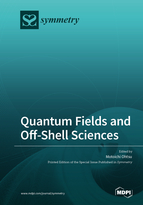Quantum Fields and Off-Shell Sciences
A special issue of Symmetry (ISSN 2073-8994). This special issue belongs to the section "Physics".
Deadline for manuscript submissions: closed (31 May 2021) | Viewed by 18127
Special Issue Editor
Special Issue Information
Dear Colleagues,
Intensive experimental studies on light–matter interactions and their associated technological breakthroughs, especially done in the field of dressed photon research, have led to a growing concern regarding unsettled off-shell quantum field interactions. In order to respond to the demand of this new tide, a new initiative has been recently launched. The aim of this Special Issue is to promote the progress of such research activities from a wider perspective, not necessarily limited to dressed photon studies. Therefore, the scope of this Special Issue covers, for instance, quantum probability theory, quantum walk model, quantum measurement theory, micro–macro duality, category theory, dynamics, vortex structure of spacetime, off the mass-shell property of quantum field and symmetry, and/or symmetry breaking of the quantum fields.
Dr. Motoichi Ohtsu
Guest Editor
Manuscript Submission Information
Manuscripts should be submitted online at www.mdpi.com by registering and logging in to this website. Once you are registered, click here to go to the submission form. Manuscripts can be submitted until the deadline. All submissions that pass pre-check are peer-reviewed. Accepted papers will be published continuously in the journal (as soon as accepted) and will be listed together on the special issue website. Research articles, review articles as well as short communications are invited. For planned papers, a title and short abstract (about 100 words) can be sent to the Editorial Office for announcement on this website.
Submitted manuscripts should not have been published previously, nor be under consideration for publication elsewhere (except conference proceedings papers). All manuscripts are thoroughly refereed through a single-blind peer-review process. A guide for authors and other relevant information for submission of manuscripts is available on the Instructions for Authors page. Symmetry is an international peer-reviewed open access monthly journal published by MDPI.
Please visit the Instructions for Authors page before submitting a manuscript. The Article Processing Charge (APC) for publication in this open access journal is 2400 CHF (Swiss Francs). Submitted papers should be well formatted and use good English. Authors may use MDPI's English editing service prior to publication or during author revisions.
Keywords
- light–matter interaction
- nanometer-sized space
- dressed photon
- quantum probability theory
- quantum walk model
- quantum measurement theory
- micro–macro duality
- category theory
- vortex structure of spacetime
- spontaneous symmetry breaking






